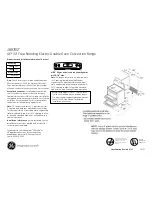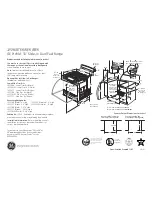
17
Convection Cooking
In a convection oven, the fan-circulated hot air continually
distributes heat more evenly than the natural movement of air in a
standard thermal oven. This movement of hot air helps maintain a
consistent temperature throughout the oven, cooking foods more
evenly, crisping surfaces while sealing in moisture and yielding
crustier breads.
During convection baking or roasting, the bake, broil, and
convection elements cycle on and off in intervals while the fan
circulates the hot air. During convection broiling, the broil and
convection elements cycle on and off.
If the oven door is opened during convection cooking, the fan
will turn off immediately. It will come back on when the oven
door is closed.
With convection cooking, most foods can be cooked at a lower
temperature and/or a shorter cooking time than in a standard
thermal oven. Depending upon the selected cooking mode,
EasyConvect™ conversion can automatically reduce the standard
recipe temperature and/or time you input for convection cooking.
If you choose not to use the EasyConvect™ conversion, use the
following table as a guide.
Convection Mode
Time/Temperature Guidelines
Convection Bake
25°F (15°C) lower temperature,
possible shortened cooking time
Convection Roast
Cooking time shortened by up to 30%
Convection Broil
Shortened cooking time
Convect Options
Convect Bake - multiple-rack baking or cookies, biscuits, breads,
casseroles, tarts, tortes, cakes
Convect Roast - whole chicken or turkey, vegetables, pork roasts,
beef roasts
Convect Broil - thicker cuts or unevenly shaped pieces of meat,
fish, or poultry
Proofing Bread
Proofing bread prepares the dough for baking by activating
the yeast. Follow the recipe directions as a guide. Proof should
be used for fresh dough, thawed dough, and for the first and
second rise.
To Proof:
Before first proofing, place the dough in a lightly greased bowl and
cover loosely with wax paper, coated with shortening. Place on
rack guide 2 and close the oven door.
NOTE:
If the temperature of the oven is greater than 120°F (49°C),
“Oven Cooling” will be displayed until the temperature is less than
120°F (49°C).
1.
Press PROOF.
2.
Press START.
Let the dough rise until nearly doubled in size. Proofing time
may vary depending on dough type and quantity.
3.
Press CANCEL UPPER when finished proofing.
Before second proofing, shape the dough, place it in baking
pan(s), and cover loosely. Follow the same placement and
control steps above. Before baking, remove the cover.
NOTE:
If the oven temperature is greater than 120°F (49°C),
the display will indicate “Oven Cooling” until the temperature
is below 120°F (49°C).
Cook Time
To Set a Timed Cook:
1.
Press BAKE or BROIL or press an Easy Convect function.
2.
Press the number keypads to enter a temperature other than
the one displayed.
3.
Press COOK TIME. The Cook Time oven indicator light will
light up.
4.
Press the number keypads to enter the length of time to cook.
5.
Press START. The display will count down the time. When the
time ends, the oven will shut off automatically.
6.
Press CANCEL for the desired oven to clear the display.
To Set a Delayed Timed Cook:
1.
Press BAKE or BROIL or press an Easy Convect function.
2.
Press the number keypads to enter a temperature other than
the one displayed.
3.
Press COOK TIME. The Cook Time oven indicator light will
light up.
4.
Press number keypads to enter the length of time to cook.
5.
Press DELAY START.
6.
Press number keypads to enter the number of hours and/or
minutes you want to delay the start time.
7.
Press START.
When the start time is reached, the oven will automatically turn
on. The temperature and/or time settings can be changed anytime
after the oven turns on by repeating steps 2 through 4. When the
set cook time ends, the oven will shut off automatically.
8.
Press CANCEL for the desired oven to clear the display.
WARNING
Food Poisoning Hazard
Do not let food sit in oven more than one hour before
or after cooking.
Doing so can result in food poisoning or sickness.










































